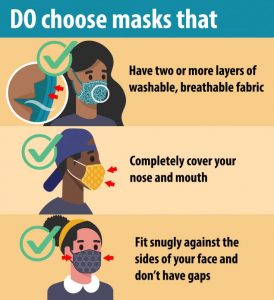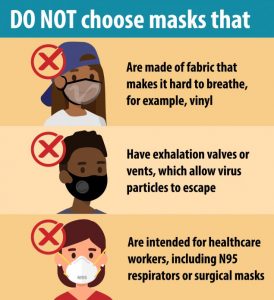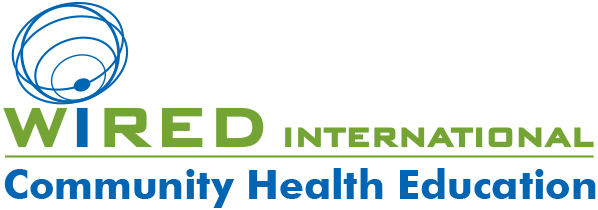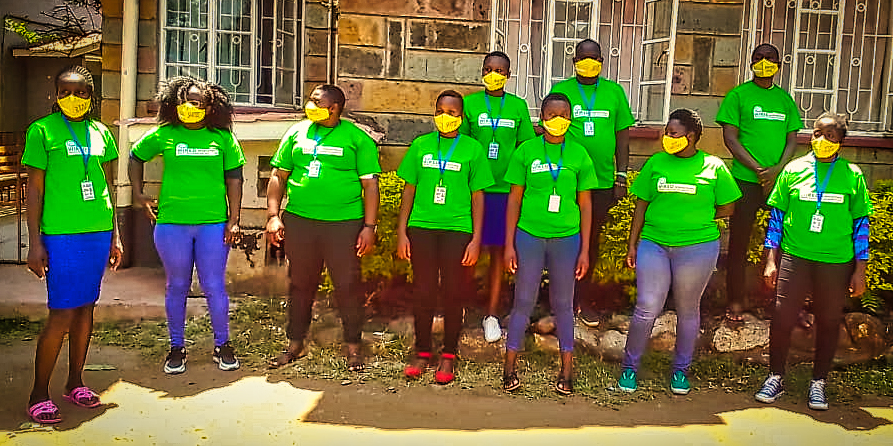Wear a Mask to Prevent Coronavirus
How and When to Use a Mask or Face Covering
By: Kristen Garabedian; Edited by Allison Kozicharow
WiRED International promotes community health by stressing the prevention of illness. Until there is a vaccine to help prevent coronavirus, wearing a mask or face covering is one of the best ways to protect yourself and your family.
 You may have heard the term “viral dose” or “viral load” in connection with mask wearing. What it means is that how much of the virus you are exposed to can determine if you get sick and how sick you get. According to a new scientific study, wearing face coverings blocks or minimizes the number of viral particles we take into our bodies. Lots of viruses can overload our immune system; fewer of them give our immune system a chance to fight the viruses off. Our immune system army can have a much better chance of defeating a smaller number of the enemy.
You may have heard the term “viral dose” or “viral load” in connection with mask wearing. What it means is that how much of the virus you are exposed to can determine if you get sick and how sick you get. According to a new scientific study, wearing face coverings blocks or minimizes the number of viral particles we take into our bodies. Lots of viruses can overload our immune system; fewer of them give our immune system a chance to fight the viruses off. Our immune system army can have a much better chance of defeating a smaller number of the enemy.
In addition to wearing a mask, washing your hands properly increases protection. Global Handwashing Day is Thursday, October 15th!
Check out the following current information from the Centers for Disease Control and Prevention (CDC) on how masks protect us from COVID-19.
When should I wear a mask?
The National Institutes of Health says you should wear a mask when:
- You are in a public place, or in an indoor space without good airflow, where you will be around people not in your household
- You cannot keep at least six feet from people you do not live with
- You are near people who are elderly, have lung or heart disease or have compromised immune systems
 Note that masks should NOT be worn by children under age 2 or anyone who has trouble breathing, is unconscious, incapacitated or otherwise unable to remove the mask without assistance.
Note that masks should NOT be worn by children under age 2 or anyone who has trouble breathing, is unconscious, incapacitated or otherwise unable to remove the mask without assistance.
How should I wear a mask?
- Wash your hands before putting on your mask.
- Put it over your nose and mouth and secure it under your chin.
- Try to fit it snugly against the sides of your face.
- Make sure you can breathe easily.
- CDC does not recommend use of masks or cloth masks for source control if they have an exhalation valve or vent.
I am healthy. Why do I need to wear a mask?
COVID-19 can be spread by people who do not have symptoms (asymptomatic people) and do not know that they are infected. Asymptomatic people may think they are healthy, but they are actually sick and can spread coronavirus to other people.
How many masks do I need?
If you can have at least two masks, you will be able to have a fresh one if the other is in the wash.
Should I wash my cloth mask or face covering?
Yes. Wash and dry your cloth mask after every wearing. Use the warmest water setting appropriate to the fabric.
How to communicate clearly while wearing a mask
or social distancing
- Ask if someone is having trouble understanding you.
- Be patient and mindful. Masks and social distancing can muffle sound and block visual clues, which can feel frustrating.
- Be loud and clear. Speak up, but don’t shout.
- Turn down background noise or move to a quieter place.
- Communicate another way. Use writing tools (paper/pen, whiteboard) or a smartphone talk-to-text application to communicate.
- Ask if your message has been understood.
Bring or be a friend. For important conversations, like talking with your doctor, bring along a friend or family member. Or offer to go to important appointments or meetings with your friend or family member, to listen and take notes.
Source: National Institutes of Health


